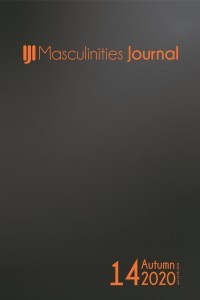Türkiye’de Erkeklik Kültürünü Yeniden Üreten ve Kuşaklar Arası Aktarımını Sağlayan Mekanizmalardan Biri Olarak “Törensel Sünnet”
Erkek Sünneti, Törensel Sünnet, Erkeklik, Erkek/Erkeklik Çalışmaları, Toplumsal Cinsiyet, Toplumsal Bellek
“Ceremonial Circumcision” as One of the Mechanisms Which Enables the Regeneration and Intergenerational Transmission of Manhood Culture in Turkey
: Male Genital Circumcision, Ceremonial Circumcision, Masculinity, Man/Masculinity Studies, Gender, Social Memory,
___
- Acara, Eda. “The Militarization of Henna”. Fe Dergi. (2) 2 (2010): 91-94. . accessed on 10 February 2014. http://cins.ankara.edu.tr/kina.pdf
- Altınay, Ayşe Gul (ed). Vatan Millet Kadınlar. Istanbul: Iletişim, 2013.
- Assmann, Jan. Kültürel Bellek. trans. Ayşe Tekin, Istanbul: Ayrıntı, 2001.
- Atay, Tayfun. “‘Erkeklik’ En Çok Erkeği Ezer!”. Toplum ve Bilim. Istanbul: Birikim Yayınları. (Autumn)102 (2004): 11-30.
- Bell, Hannah Rachel. Erkek İşi Kadın İşi. trans. Meltem Erkmen. Istanbul: Epsilon, 2003.
- Castells, Manuel. Kimliğin Gücü, trans. Ebru Kılıç, Istanbul: Bilgi Üniversitesi Yayınları, 2006.
- Connell, R. W. Toplumsal Cinsiyet ve İktidar. trans. Cem Soydemir. Istanbul: Ayrıntı, 1998. Cornwall, A., Lindisfarne N. “Dislocating Masculinity-Gender, Power and Antropology”. in Cornwal A and Lindisfarne N. (ed)Dislocating Masculinity Ethnographies. London: Routledge, (1994): 11-47.
- DeMeo, J. “The Geography of Genital Mutilations”. The Truth Seeker. (1989): 9-13. accessed on 9 January 2014. http://www.noharmm.org/geography.htm,
- Enloe, Cynthia. “Feminizm, Milliyetçilik ve Militarizm”, in Ayşegül Altınay (ed), Vatan, Millet, Kadınlar, Istanbul: Iletişim, (2013): 223-226.
- Erdoğan, İlker (ed). Medyada Hegemonik Erkek(lik) ve Temsil, Istanbul: Kalkedon, 2011.
- Glick, Leonard B. “The Life Of The Flesh Is In The Blood” in Denniston, George et al. (eds), Bodily Integrity and the Politics of Circumcision. New York: Springer, (2006):17-30.
- Gollaher, David. Circumcision: A History of the World’s Most Controversial Surgery. New York: Basic Book, 2000.
- Gün, Nil. Sünnet. Istanbul: Kuraldışı Yayınları, 2005. I mmerman, Ronald S. and Mackey, Wade C. “A Biocultural Analysis of Circumcision”. Social Biology. (44)3-4 (1997):267-273. accessed on 9 January 2014. http://www.cirp.org/library/psych/immerman2/.
- Kandiyoti, D. Cariyeler, Bacılar, Yurttaşlar. trans. Aksu Bora. Istanbul: Metis, 2013.
- Kimmel, M., Kaufman, M. “Weekend Wariers: The New Mens Movement”. in H. Brod and M. Kaufman (ed). Theorizing Masculinities. Lodon: Sage, 1994.
- Kuruoğlu, Huriye (ed). Erkek Kimliğinin Değişe(meye)n Halleri. Istanbul: Beta Basın Yayım, 2009.
- Montagu, Ashley. “Mutilated Humanity”. a paper presented to the Second International Symposium on Circumcision, 1991. accessed on 15 January 2014, http://www.nocirc.org/symposia/second/montagu.html.
- Nagel, Joane. “Erkeklik ve Milliyetçilik: Ulusun İnşasında Toplumsal Cinsiyet ve Cinsellik”. in Ayşegül Altınay (ed), Vatan, Millet, Kadınlar. Istanbul: Iletişim, (2013): 65-96.
- Paige, Karen Erickson. “The Ritual of Circumcision”. Human Nature. (1978): 40-48, accessed on 15 February 2014, http://www.noharmm.org/paige.htm.
- SALAM, Seham Abd El. “Male Genital Mutilation (Circumcision): A Feminist Study of a Muted Gender Issue”. trans. Azza Ali, Seham Abd el Salam. Master thesis. American University in Cairo. 1999. accessed on 30 December 2013. http://noharmm.org/muted.htm.
- Sancar, Serpil. Erkeklik: İmkansız İktidar. Istanbul: Metis, 2009.
- Segal, Lynne. Ağır Çekim: Değişen Erkeklikler Değişen Erkekler. trans. Ersoy. V.. Istanbul: Ayrıntı, 1990.
- Selek, Pınar. Sürüne Sürüne Erkek Olmak. Istanbul: İletişim, 2009.
- Sharabi, Rachel. "The Bride's Henna Ritual: Symbols, Meanings and Changes". Nashim: A Journal of Jewish Women's Studies & Gender Issues (11)1 (2006): 11-42.
- Silverman, Eric K. “Anthropology and Circumcision”. Annual Review of Anthropology. Vol.33. (2004): 419-445.
- Taburoğlu, Özgür. Dünyevi ve Kutsal. Istanbul: Metis, 2008.
- Taşıtman, Ayşegül. “Kutsal Erkekliğin İnşasında Bir Durak: Sünnet Ritüeli”. in N.Gamze Toksoy (ed). Bellek İzleri. Istanbul: Kalkedon, 2012
- Başlangıç: 2014
- Yayıncı: Eleştirel Erkeklik İncelemeleri İnisiyatifi
Ötekileştirilen Siyahi Erkek: Afro-Amerikan Lezbiyen Erotik Kurgularda Erkeklik İmajı
“Ucundan Azıcık”la Atılan Sağlam Temel: Türkiye’de Sünnet Ritüeli ve Erkeklik İlişkisi
N. Gamze TOKSOY, Aysegul TASİTMAN
Erkek Millet, Asker Millet: Türkiye’de Militarizm, Milliyetçilik, Erkek(lik)ler
Tehdit Edilmiş Erkeklikler: Ruanda Kırsalındaki Erkeklerin Toplumsal Cinsiyet Eşitliği Deneyimleri
Gerçek Erkek Ayağa Kalkabilir mi Lütfen: Trans Erkeklerin Cinsiyetlendirilmiş Performansı
“Drag”ler, Uyuşturucular ve Kir: Marilyn Manson’un Müzik Videosu “(s)Aint’’de Iğrenti ve Erkeklik
Eros and Tragedy: Jewish Male Fantasies and the Masculine Revolution of Zionism
